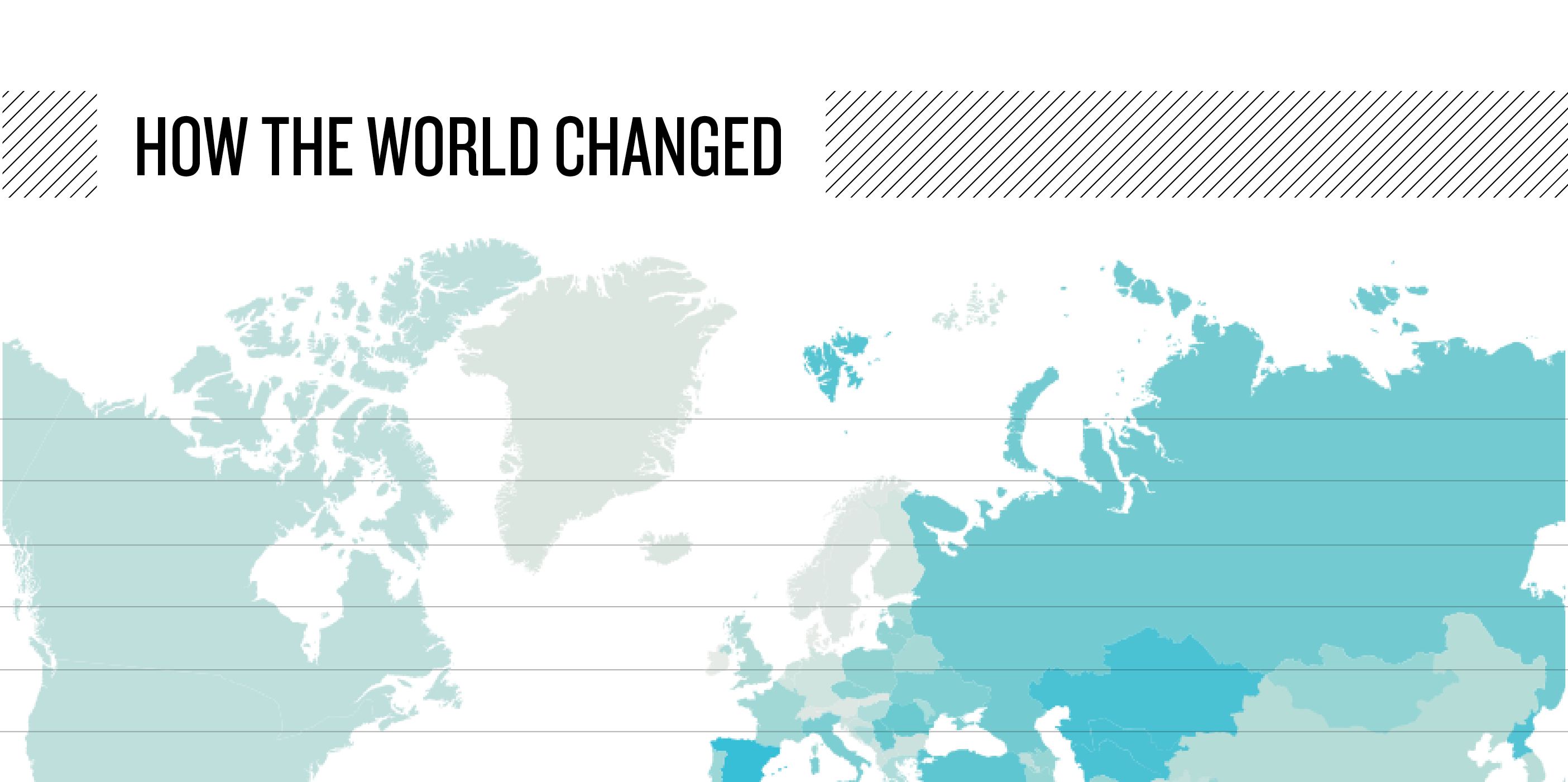
The Impact of the Global Pandemic on Human Activity: Part III
The Top Line
- Total worldwide steps decreased by 12% in April 2020
- Worldwide steps from just workout activities increased by 24%
- More people are exercising, but in different ways, to make up for the coronavirus’ suppression of normal daily movement
Years from now when we look back at this pandemic, we will remember April as the month the coronavirus extended its debilitating reach to nearly every country, culture and community on Earth. While the ways in which it has affected our daily lives are many, we at Garmin have considered it our duty to analyze and report on the impact it’s having on human activity.
Total Steps
When comparing April 2020 to April of last year, we see a clear reflection of the pandemic’s crippling global power. Aggregated data from millions of Garmin users shows a worldwide decrease of 12% in average daily steps. You can see which countries experienced steeper drops than others on the heat map below.
When viewing an aggregation visual at this large of a global scale, it is important to note that we are applying a fixed data scale to every country in the world. For this reason, results will be magnified for countries with lower population counts and stricter stay-at-home orders. Case and point: The U.S. compared to Uzbekistan. While Uzbekistan is nowhere near the U.S. in number of coronavirus cases, it has a bigger percentage decrease because there are fewer people and stricter lockdown rules.
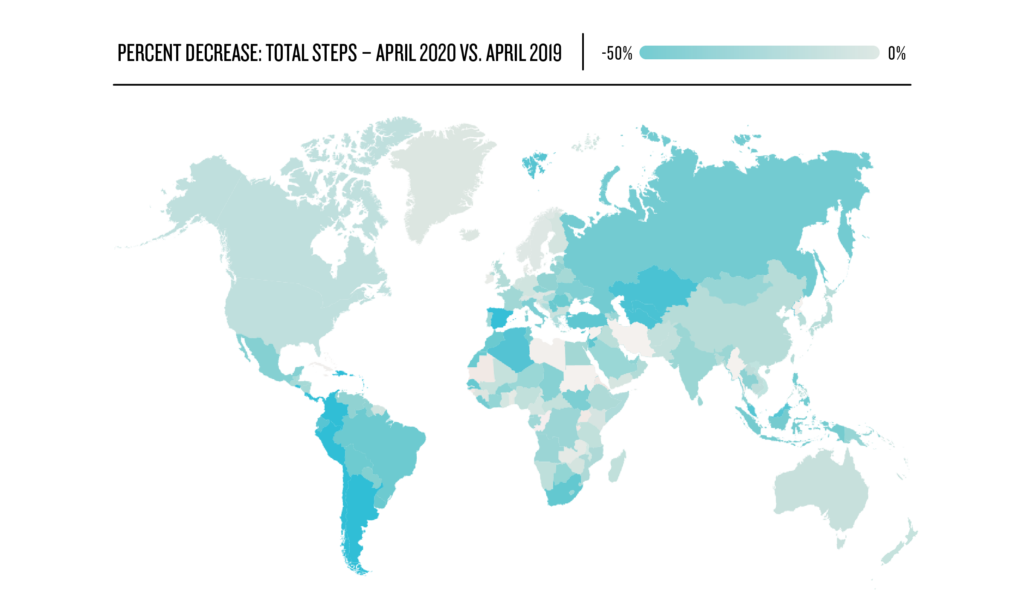
Workout Activity-based Steps
While the slowdown in movement is clear, if we take a deeper dive into the data, things get even more interesting.
A portion of these total worldwide steps comes from uploaded activities such as walking, running and hiking (there are more than 20 built-in activity apps in Garmin devices). If we look at just the steps coming from these logged activities, we find the opposite trend.
On average, steps from logged activities were up 24% worldwide. A likely conclusion: To make up for lost steps in their everyday routines, people began engaging in exercise activities.
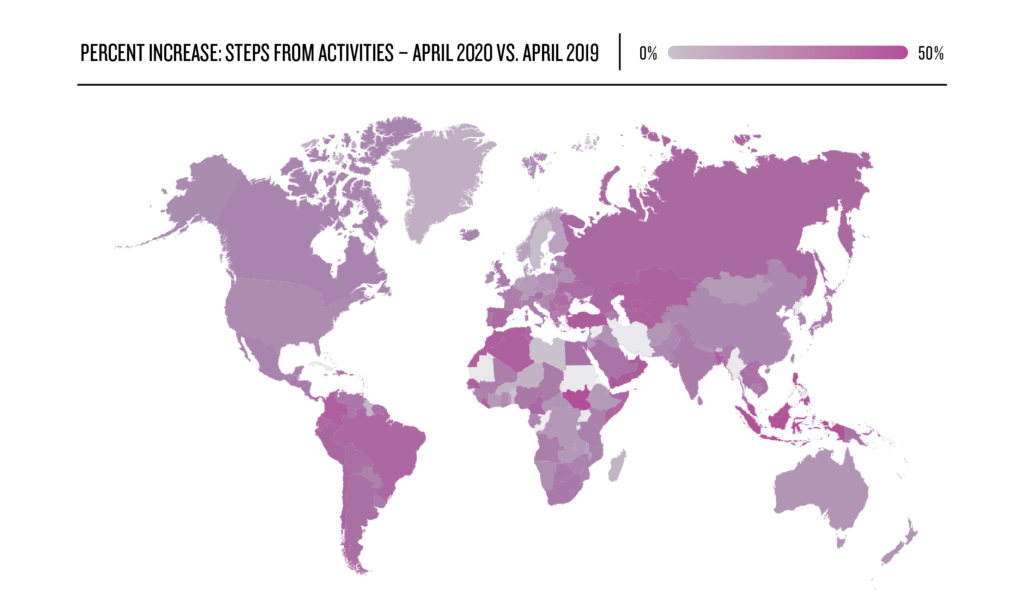
Biggest Activity Type Increases by Country
So what specific activities are Garmin users around the world turning to? And does it vary by geographic location? We highlighted some of these answers in our previous posts on data trends in the U.S. and Europe. Now we can see a complete global picture. Here are the activities that saw the largest increase in each country, when comparing April 2020 to April 2019.
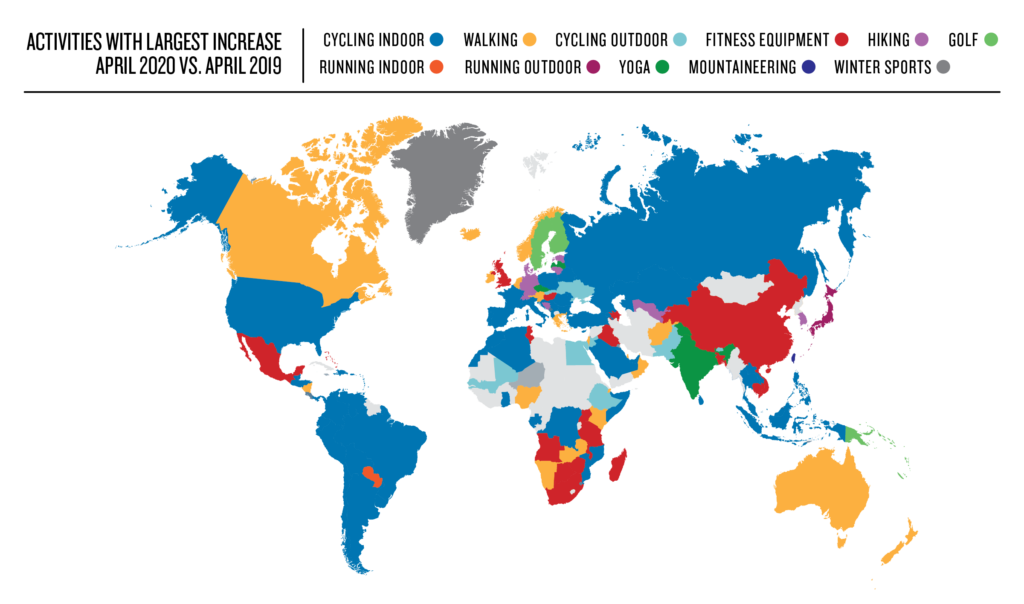
Australians and Canadians may have differing opinions on whether cricket or hockey is more fun to watch, but both seem to agree that walking is the best activity during life in quarantine.
In China, Mexico, South Africa and a handful of other countries, fitness equipment workouts increased more than any other activity. Globally, when we look at what types of fitness equipment workouts are being performed, we see that indoor cardio accounts for 50% of them. Last year during the same time period, over 50% of the activities in this category were strength training. This could indicate a shift from gym-structured workouts to home-based “find-a-way” workouts.
Of course, we’d be remiss not to call out the blue wash over much of the map above. The global movement to indoor cycling is undeniable. While we’ve reported extensively on the statistics around the global shift to this activity in previous articles, we decided to consult a couple of Garmin pro athletes this time around for some qualitative context:
“Currently, I am in France where I am not able to bike outside,” says U.S. triathlete Taylor Spivey, who has been Europe since the quarantine began. “I went from never doing an indoor ride in months to riding inside five times per week.”
“We are definitely spending more time on platforms like Zwift,” says Colorado-based triathlete Mirinda Carfrae. “Our training group meets once every 2 weeks to do a session together – just one way to keep in contact with [everyone] we would normally see almost daily.”
Biggest Activity Type Decreases by Country
While the pandemic has pushed humanity toward some activities, it has decisively turned it away from others. In a previous article that focused on European trends, we noted that swimming had all but disappeared. As we compare April 2020 to April 2019, this looks to be a global trend too. The data shows significant decreases in swimming activity from the Americas to the Far East.
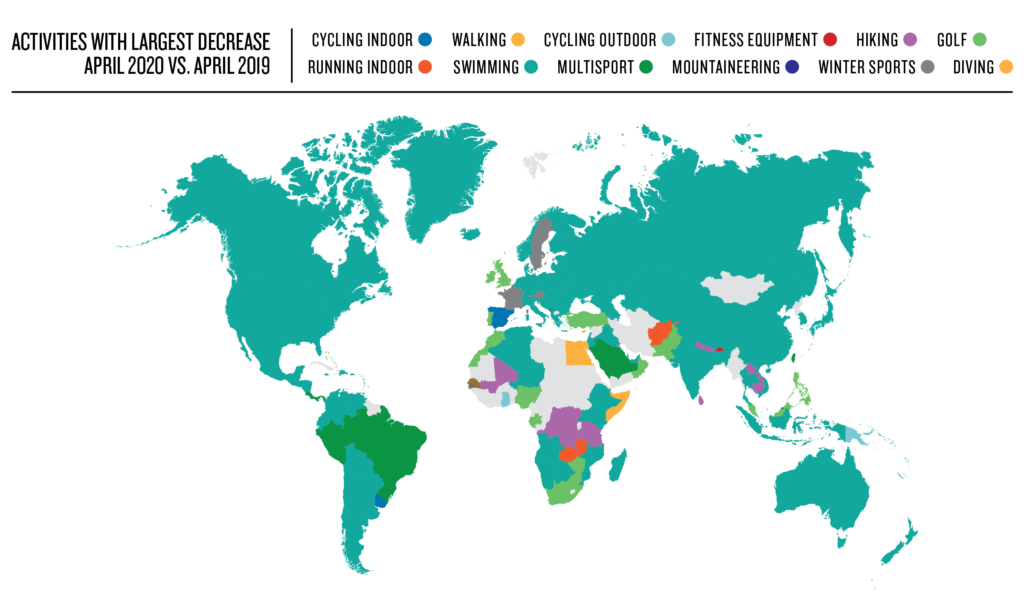
But swimmers aren’t sitting on the sidelines. In Australia, the data shows that 54% of the users who swam in April 2019 are instead running outdoors in April 2020. In China, 43% of the users who swam in April of last year are either running or biking outside this year. And in the U.S., pro triathlete Paula Findlay is putting in the work at home.
“Since all pools are closed in Oregon where I live, I’m doing more gym and strength work at home,” says Findlay. “I’m trying to replicate some of the movements and muscle patterns of swimming.”
Multisport training, along with hiking and golf also ranked as the activities with the largest decreases in multiple countries. But like swimmers, these folks look to be finding alternatives. In South Africa, for example, 20% of the users who were golfing in April 2019 turned to indoor fitness workouts in April 2020, while another 11% began indoor cycling.
“I would imagine that all athletes across all sports are using this time to prepare their bodies for when sports return,” says pro golfer Greg Norman. “My house is currently undergoing construction, so I have used this time to get my hands dirty and work outside with the crew.Every day you can find me digging trenches, laying sod, working with heavy machinery – a lot of manual labor in the hot Florida heat! I have also maintained my normal activities like daily gym sessions, tennis and surf skiing.”
Now What?
After analyzing the activity trend data for two months, we’ve used the phrase “fitness is finding a way” as a recurring theme. While the data does support this conclusion, technically speaking, it’s the people who are finding a way. From the mainstream to professional athletes, people are adapting routines but clearly not stopping them.
“I have always drawn so much strength from running with teammates,” says world champion distance runner Alexi Pappas, who is currently in Greece. “I feel that at its best, running is a team sport. But now, since it is not yet safe to run in groups, I’ve turned to listening to audiobooks on my runs. I’ve ‘read’ so many books that I never would have discovered before. It’s not the same as running with teammates, but it has grown into an alternative that I really enjoy.”
Team activity will eventually return. But for now, finding a good book to keep you company on your workout isn’t a bad idea. It’s just one of the millions of routine adjustments being made all over the world.




